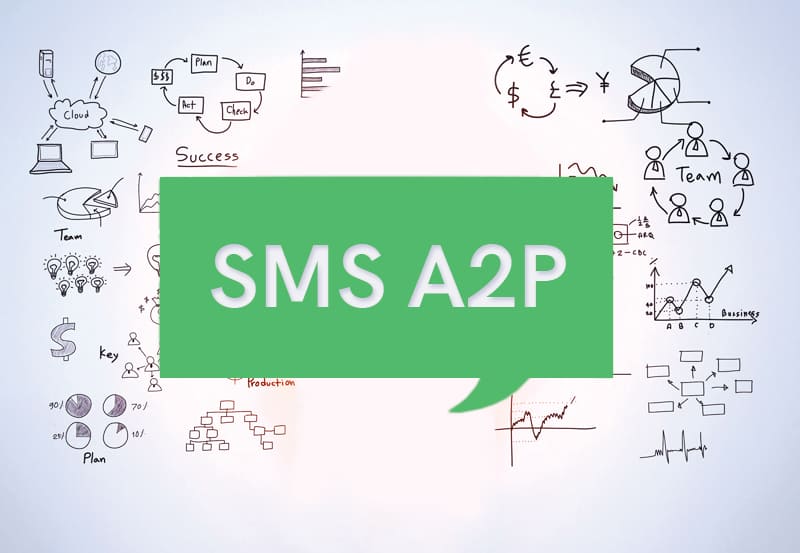There are more moving messages going back and forth in the world today than ever in the history of humanity; and although the SMS channel is over 20 years old, it seems that text support is on the verge of a new era.
Since the beginning of the decade, the mobile phone industry has observed the rise of high-end messaging (OTT) apps as Whatsapp; Facebook Messenger e WeChat with cautious interest. While there has been much debate as to whether these services will complement or compete with SMS; OTT apps have already eclipsed SMS as the primary medium for P2P (person-to-person) communications across all demographics.
However, instead of OTT messaging completely eradicating SMS as some have predicted; SMS has actually found a happy balance as something of a fail-safe backup in the event of no data coverage or OTT fragmentation.
From P2P to A2P messaging
Despite this stiff competition, that's not how the SMS story ends. While SMS may be more of the first choice for consumers, in the corporate sector its use for customer engagement in all its forms is accelerating rapidly - and with good reason.
While messaging apps have improved functionality, SMS remains the only ubiquitous global messaging platform and the only one with a unique and globally recognized addressing system. It works on any phone and any network and is also the most trusted by consumers. These make it appropriate for all types of corporate and mission-critical communications.
As a result, companies in multiple verticals such as financial, commercial and healthcare are increasingly turning to SMS. In recent years, the so-called application-to-person (A2P) market has seen tremendous growth, according to which mobile analyst SQUARED expects a value of nearly $ 60 billion by 2020, compared to $ 12 billion in 2015.
The consensus among industry analysts is that A2P will continue to grow significantly, with Credence Research recently predicting that businesses will broadcast two trillion SMS messages per year by 2017.
One of the reasons for the optimism surrounding A2P messaging is based on the ease with which SMS has become integrated. Developers can easily build apps that message users entirely via software. They don't need to negotiate with MNOs or aggregators and using a simple API in their apps, they can send SMS messages to users.
This simplicity has helped accelerate the adoption of A2P messaging. The 2016 Mobile Messaging report from MEF's global mobile commerce body found that consumers' 76% receives SMS communications from businesses such as banks, healthcare and retailers, while the 65% interacted with businesses via chat apps.
Financial services lead the way for messaging A2P
The financial services industry is currently at the forefront of A2P messaging, with 33% of people receiving an SMS message from a financial institution. This compares to a school's 17%, a healthcare provider's 16%, and even a retailer's or e-commerce company's 23%.
There are probably two reasons for this. The first is that one-time password texts are an important part of banking authentication (e.g. when setting up a new payee). In fact, another finding shows that “confirm a password” is the most common use case for A2P SMS. It has been used by people's 30% at least once in the past year.
The other likely reason for so much textual activity with banks could be the savings on fees. In the UK, for example, text notices have largely replaced letters as a means of informing a customer that they are approaching the overdraft limit. The ability to act on this notice saves customers millions of pounds.
In fact, in 2015 the Financial Conduct Authority (FCA) said that subscribing to text alerts and mobile banking apps reduces the amount of unsorted overdraft charges incurred by up to 24%.
These developments reflect a constant migration from physical banking services. Around the world, new “challenger” banks are opening - Fidor, Number 26, Tandem, Mondo and many more - that exist purely as app-based digital entities.
However, currently the most popular “business use” of SMS is the confirmation of a password through a two-factor authentication process.
The future of A2P messaging
SMS is entering a new and exciting era; driven by its unmatched versatility and simplicity of API integration. As a result, businesses are finding texting increasingly effective for a growing multitude of customer-centric businesses, but this may just be the beginning.
Growth in IoT device deployment has connectivity at its core. Furthermore, Machina Research predicts that 2.2 billion devices will be connected via mobile networks by 2024. And how, for example, will a connected car communicate the fact that it has a faulty part for a service technician? SMS of course.
However, the next phase of A2P's growth could herald an even more fundamental evolution in the relationship between business and consumer: the shift towards “conversational” commerce. It describes text-based communications between a customer and a company that happen in real time, like a conversation.
In essence, customers will be able to "chat" with a bot as if it were a human operator. Many believe that conversational commerce can define the next stage in brand / consumer communications and make messaging apps even more central to people's lives with SMS playing a central role.







